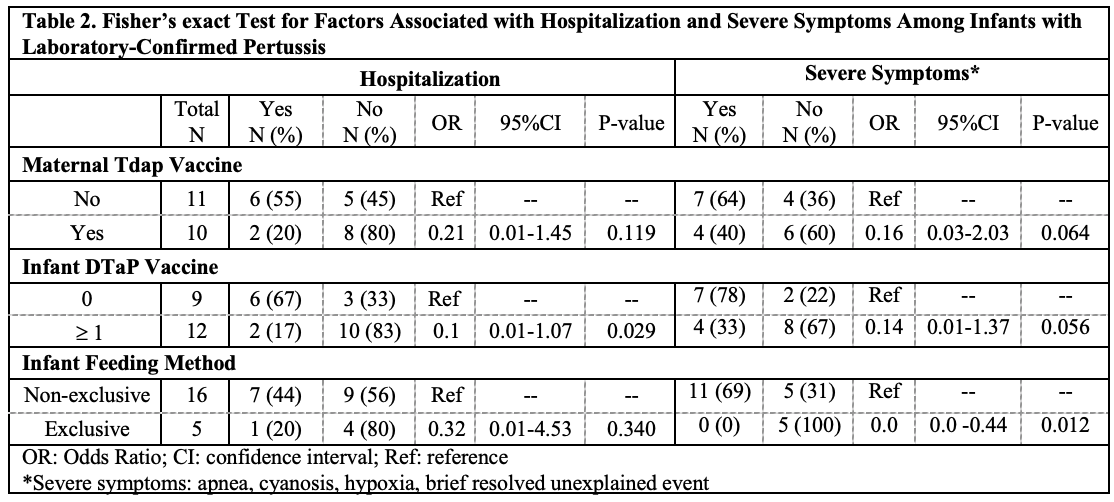Infectious Diseases
Category: Abstract Submission
Infectious Diseases: Bacteria & Antimicrobials
305 - Risk Factors for Pertussis Infection in Infants
Friday, April 22, 2022
6:15 PM - 8:45 PM US MT
Poster Number: 305
Publication Number: 305.114
Publication Number: 305.114
Oluwatosin A. Aluko, University of Pittsburgh School of Medicine, Grand Blanc, MI, United States; Judith M. Martin, University of Pittsburgh, Pittsburgh, PA, United States; Anne-Marie Rick, University of Pittsburgh School of Medicine, Pittsburgh, PA, United States
.jpg)
Oluwatosin A. Aluko, B.S.
Medical Student
University of Pittsburgh School of Medicine
Pittsburgh, Pennsylvania, United States
Presenting Author(s)
Background: Unvaccinated or incompletely vaccinated infants comprise 90% of pertussis-related deaths. Understanding risk factors for pertussis allows us to better protect infants and combat vaccine hesitancy.
Objective: We aimed to compare maternal and infant pertussis immunization and breastmilk exposure between infants with pertussis and matched controls and to assess risk factors for severe pertussis.
Design/Methods: Using an existing retrospective cohort of 48,871 mother-infants pairs identified within a health-system in Pennsylvania from 2011-2019, we identified infants < 1 year with laboratory-confirmed Bordetella pertussis or parapertussis. Four randomly selected controls were matched by birthdate to each case. Electronic health records were reviewed for relevant variables. Univariate logistic regression was used to compare cases and controls for maternal Tdap and infant DTaP immunization, and breastmilk exposure. Among infants with pertussis, Fisher’s exact test was used to assess factors associated with infant hospitalization and severe symptoms (apnea, cyanosis, hypoxia, or brief resolved unexplained event).
Results: 21 infants had pertussis and were matched to 84 controls. Median age of cases was 147 days (range 37-353 days). 10 (48%) had mothers immunized with Tdap during pregnancy, 12 (57%) infants had received ≥1 DTaP vaccine and 5 (24%) were exclusively breastfeeding. 11 (52%) had severe symptoms and 8 (38%) required hospitalization.
Infants with pertussis were 96% less likely to have 3 doses of DTaP compared to controls (p=0.044; Table 1). While mothers of cases were half as likely to have received Tdap during pregnancy or to be exclusively breastfeeding at time of illness, these did not reach level of significance. Less maternal education was strongly associated with pertussis diagnosis (OR:0.12; p=0.007).
Infants were less likely to be hospitalized if they had ≥1 dose of DTaP (OR:0.1; p=0.03) or were ≥90 days old at time of diagnosis (OR:0.06; p=0.0112; Table 2). Infants were less likely to have severe symptoms if they were exclusively breastfeeding (OR:~0.0; p=0.012). Severity was also reduced among infants with ≥1 dose of DTaP (86%) and a mother immunized with Tdap during pregnancy (84%) although not at the level of significance.Conclusion(s): Immunization with DTaP reduces risk of infection and likely severity of pertussis in infants < 1 year. Clinicians should use these data to reinforce DTaP administration according to national guidelines. Maternal Tdap during pregnancy and breastfeeding are likely important factors in protection but may be more critical during early infancy (0-3 months).
Oluwatosin Aluko's Resume.pdf
Table 2. Fisher’s exact Test for Factors Associated with Hospitalization and Severe Symptoms Among Infants with Laboratory-Confirmed Pertussis
Objective: We aimed to compare maternal and infant pertussis immunization and breastmilk exposure between infants with pertussis and matched controls and to assess risk factors for severe pertussis.
Design/Methods: Using an existing retrospective cohort of 48,871 mother-infants pairs identified within a health-system in Pennsylvania from 2011-2019, we identified infants < 1 year with laboratory-confirmed Bordetella pertussis or parapertussis. Four randomly selected controls were matched by birthdate to each case. Electronic health records were reviewed for relevant variables. Univariate logistic regression was used to compare cases and controls for maternal Tdap and infant DTaP immunization, and breastmilk exposure. Among infants with pertussis, Fisher’s exact test was used to assess factors associated with infant hospitalization and severe symptoms (apnea, cyanosis, hypoxia, or brief resolved unexplained event).
Results: 21 infants had pertussis and were matched to 84 controls. Median age of cases was 147 days (range 37-353 days). 10 (48%) had mothers immunized with Tdap during pregnancy, 12 (57%) infants had received ≥1 DTaP vaccine and 5 (24%) were exclusively breastfeeding. 11 (52%) had severe symptoms and 8 (38%) required hospitalization.
Infants with pertussis were 96% less likely to have 3 doses of DTaP compared to controls (p=0.044; Table 1). While mothers of cases were half as likely to have received Tdap during pregnancy or to be exclusively breastfeeding at time of illness, these did not reach level of significance. Less maternal education was strongly associated with pertussis diagnosis (OR:0.12; p=0.007).
Infants were less likely to be hospitalized if they had ≥1 dose of DTaP (OR:0.1; p=0.03) or were ≥90 days old at time of diagnosis (OR:0.06; p=0.0112; Table 2). Infants were less likely to have severe symptoms if they were exclusively breastfeeding (OR:~0.0; p=0.012). Severity was also reduced among infants with ≥1 dose of DTaP (86%) and a mother immunized with Tdap during pregnancy (84%) although not at the level of significance.Conclusion(s): Immunization with DTaP reduces risk of infection and likely severity of pertussis in infants < 1 year. Clinicians should use these data to reinforce DTaP administration according to national guidelines. Maternal Tdap during pregnancy and breastfeeding are likely important factors in protection but may be more critical during early infancy (0-3 months).
Oluwatosin Aluko's Resume.pdf
Table 2. Fisher’s exact Test for Factors Associated with Hospitalization and Severe Symptoms Among Infants with Laboratory-Confirmed Pertussis

